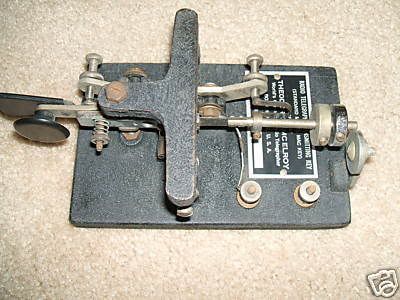BIG MAC (KEY) ATTACK. A couple of weeks ago I decided to snipe an eBay item I had watched for most of a week. The item? Another McElroy Mac Key, this was a 1938B version of the base key. This version of the Mac Key did not have the unique “marbelized” finish; the key was painted in black crinkle finish. It lacked the dot stabilizer and the circuit closer switch the DeLuxe key had.
But this key was exceptionally nice and original. I decided the bidding was low enough to make it worth my time to chase it. And win it I did. I paid the man and waited.

From the auction listing I could tell the seller was one of the many folks who buy boxes of stuff at estate sales and post it on eBay. He didn't know squat about telegraph keys — and more importantly, he didn't know squat about how to properly pack a 4-pound telegraph key.
He put the key in a USPS priority mail box with a handful of peanuts and some wads of newspaper. Ugh!! I could tell by the telltale punctures in the box that the key had had a very hard ride to my QTH.
I was horrified when I opened the box.
The key had violently banged around inside the box, penetrating it on the ends in mulitple places where the one end (or the other) of the keying lever punched a hole in the box. The original Mac thumbpiece (paddle) was broken off, and on the far end of the key, the damper mount was bend like a dog's hind leg. Double UGH!
The keying lever itself had been crunched so hard that the lever was bent at the leaf spring in two directions. I pulled the auction listing back up to check to make sure this was the key I bid on and won: Yep, it was, but it didn't look like it now.
I had to decide how badly I wanted this key. Was it still worth the price since it was damaged in transit? Could I repair or replace the damage? I'm a big fan of McElroy keys, so I decided to keep the key rather than file a complaint with PayPal.
The bends in the leaf spring took some very CAREFUL work to get it straightened out. It looks as good as new, though I was sweating bullets for a few moments (spring steel is easy to break, particularly after its been bent and you're trying to straighten it). The bend damper mount was a tough nut, too. It's rather thick chrome-plated steel, so straightening it took some padded pliers, a vise and very careful application of force. It came out none the worse for wear.
The broken paddle looked like a lost cause. I found a missing shard of plastic in the box, and with care, I was able to crazy glue it together. It looks fairly good, and unless you're looking hard at it you'll never notice it was broken.
After some extensive cleaning of the silver contact points, the key works pretty well again. The only issue it still has is continuity between the dash lever and the rest of the keying lever. Sometimes when you push the dash lever ot the left it doesn't make solid contact, resulting in a scratchy, choppy or intermittent dash. I've had this before on older Vibroplex keys, and the solution is to use contact spray and clean the years of crud out from around the pivot point on the dash lever (in order for the dash lever to make and keep solid contact with the keying lever whenever the dash lever is moved). It's not super critical right now, but I'm going to have to fix it.
ELECTRICAL NOISE PLAGUE. Worse than locusts, more insidious than pestilence, my QTH has been taken over by a curtain of electrical noise that is driving me (and the noise blanker in my FT-2000) insane. The electrical noise is showing up on the bandscope like a series of spikes across the entire sweep, registering a solid S8 or S9.
I can still copy weaker signals, but who wants to struggle to listen through that kind of hash?? Static crashes are nearly as annoying as this stuff.
I've got to check around the house to see what might be generating it (wall wart, charger, etc.), or it may be something outside due to the extra dry weather. If I have a chance tomorrow I'll listen for it in the car or a handheld AM radio. It's audible on every ham band I've monitored tonight.
The Noise Blanker on the FT-2000 only reduces it some, it won't take it out. If I had my IC-746PRO back I would see how it fares in a homespun “Noise Blanker Shoot-out” with the FT-2000.
In the meantime I'll work to see if I can localize what's generating the noise.
